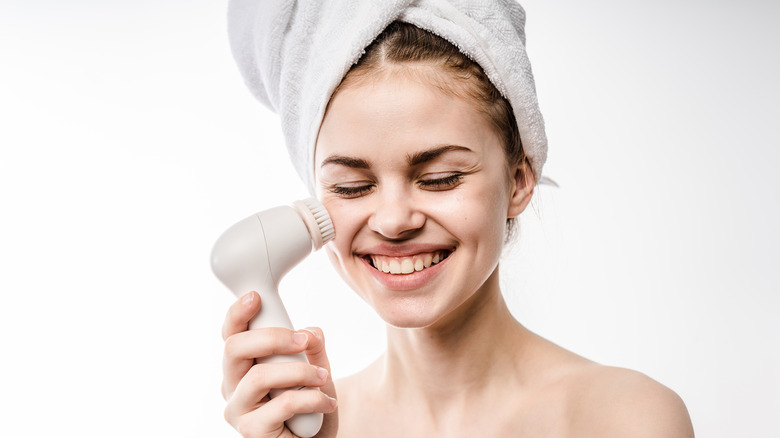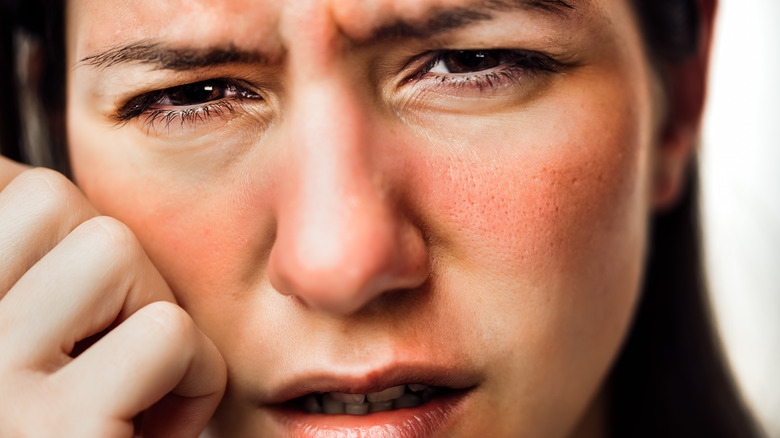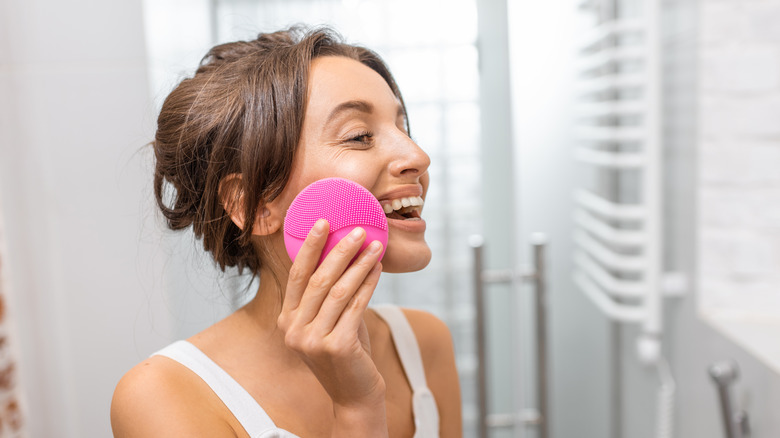The Downsides To Facial Cleansing Brushes Are Nothing To Scoff At
Having a skincare routine is important, so many of us are consistently looking for new additions to perfect our regimen. Since the appearance of brands such as Clarisonic and Foreo, facial cleansing brushes have been a consistent go-to for those looking to get the best skin possible. Of course, there are many types of facial brushes, with the three main types being oscillating brushes, ultrasonic vibrating brushes, and non-electric bristle brushes.
No matter what type of facial cleansing brush you choose, they all have the same purpose — to leave the skin as clean as possible. These brushes use bristles to scrub away debris, dirt, and dead skin cells off the face, leaving you with a smooth surface. Unfortunately, all good things often have a downside, including facial cleansing brushes. When used on the wrong skin types (or not cleaned correctly), a facial cleansing brush can cause more harm than good, leading to more bacterial acne, irritated skin, and premature aging.
When to avoid using a facial cleansing brush
Facial cleansing brushes are not one-size-fits-all, as they are not the best choice for certain skin types and conditions. If you have naturally sensitive skin, depending on the severity, you should never (or rarely) use a facial brush. Our skin has a natural moisture barrier that is easily disrupted. Some people's barriers become more easily disrupted than others. When the barrier is disrupted, it may create redness and irritation of the skin, not to mention leave it more susceptible to damage and premature aging. Try patch testing a facial brush on sensitive skin to see your results, if you see no negative side effects, it is most likely suitable for use once every few days. Never use a facial cleansing brush daily if you have sensitive skin.
Many people also use facial cleansing brushes because they think they can cure their acne — but they may actually do the opposite. "Certain types of acne can also be worsened by aggressive cleansing with brushes (mostly comedonal acne, like blackheads and whiteheads)," dermatologist Tiffany Link tells Byrdie. This is once again due to disruption of the skin barrier, as it can change the skin's pH and ultimately increase oil production (rather than decrease excess sebum). She recommends speaking to a dermatologist before using a facial cleansing brush if acne is your biggest pain point.
How to prevent bacteria buildup on your cleansing brush
One of the nastiest downsides to facial cleansing brushes is the number of bacteria, dirt, and debris they can hold. When bacteria builds up on your cleansing brush without being washed off, it can be transferred back onto the skin, leading to potential breakouts. This is particularly prominent in nylon bristles, as silicone bristles (such as those on the Foreo devices), cannot harbor bacterial buildup — as they are non-porous.
Brushes with nylon bristles can hold bacteria in a similar way that your toothbrush does, requiring replacement every two to three months. In the meantime, facial cleansing brushes can be cleaned and stored to prevent the buildup of bacteria. To cleanse your facial cleansing brush of any bacteria after each use, simply wash the bristles with anti-bacterial soap and a designated toothbrush to get in between the cracks. "Wet bristles are a breeding ground for mold and bacteria," says Ranella Hirsch, M.D. to Prevention. Make sure you are leaving your facial cleansing brush in a cool and dry environment after cleaning.


